Melbourne Tram Museum
- Follow Melbourne Tram Museum on Twitter
- Follow Melbourne Tram Museum on Facebook
- Follow Melbourne Tram Museum on Instagram
- Follow Melbourne Tram Museum on Pinterest
- Follow Melbourne Tram Museum on Tumblr
- Subscribe to Melbourne Tram Museum's RSS feed
- Email Melbourne Tram Museum
Melbourne & Metropolitan Tramways Board X Class No 217
Two single truck Birney Lightweight Safety Cars were imported by the Melbourne & Metropolitan Tramways Board from the United States in 1923, Nos. 217 and 218. Designed by Joseph M. Bosenbury and Charles O. Birney, several thousand of these tramcars were constructed in the USA between 1915 and 1926, however only a few survive. Six similar tramcars were imported around the same time for use in Geelong and Port Adelaide. The two Birney cars were the last imported from the USA for use in Melbourne. This particular example was built by the famous J.G. Brill Company of Philadelphia.
 M&MTB No 217, 1973.
M&MTB No 217, 1973. - Photograph courtesy Mal Rowe.
These tramcars were designed to meet the challenge of motor omnibuses, by providing a tram which was cheap to construct and could be operated economically on low density passenger routes by single man crews. They were fitted with a number of advanced safety features including a controller interlocked with the brakes, car doors and sanding mechanism, so that the tram could not be moved until the doors were closed. These were also the first Melbourne trams fitted with air operated doors.
Unfortunately, the ride of these cars was not smooth, the wooden seats decidedly uncomfortable and the level of comfort of rapidly-evolving motor omnibuses soon overtook what was offered in Birney cars. Therefore, the same simplicity of design was not repeated, and when the M&MTB came to build its copy of the Birney design in the subsequent X1 and X2 class tramcar designs, the seats were fully upholstered.
No 217 is finished in early M&MTB chocolate and cream livery with white rocker panels. It is also fitted with two trolley poles, which while originally fitted were removed due to lack of strength in the roof and replaced with bow collectors in 1924 as an experiment. A single trolley pole subsequently replaced these.
These tramcars were used mainly on the Hawthorn and Point Ormond routes, together with use over all the Melbourne system as all-night cars. No 217 was allocated to Footscray Depot in 1956, but received little use prior to being withdrawn in February 1957, when all-night tram services were discontinued. It was acquired by the Australian Electric Traction Association in 1957, and transferred to the ownership of the Tramway Museum Society of Victoria in 1963, which restored it to original condition at the rear of Malvern Depot.
There are six other Birney tramcars surviving in Australia – five in Bendigo and one at the Australian Electric Traction Museum in St Kilda, South Australia.
In 1992, this tramcar was placed on long-term loan to the Victorian State Government, and it is now on display as part of the collection of the Melbourne Tram Museum.
Technical details
| Motors: | 2 x 25hp (GE 264) |
| Controller: | GE K63G |
| Truck: | Brill 79E |
| Passengers: | 33 (seated), 17 (standing) |
| Weight: | 8.2 tons |
| Length: | 28 feet 0 inches |
| Width: | 8 feet 4½ inches |
Bibliography
Brill, D. (2001) History of the J.G. Brill Company, Indiana University Press
Cross, N., Budd, D., and Wilson, R. (1993) Destination City (Fifth Edition), Transit Australia Publishing
Cross, N., Henderson, R. and Kings, K. (1981) Destination City (Fourth Edition), Australian Electric Traction Association
Kings, K.S. and Richardson, J. (1965) Destination Eaglehawk, Traction Publications
O’Neil, D. (1994) History of the Geelong Electric Tramways 1912-1956, David J. O’Neil
Wheaton, R. (1975) Destination Paradise, Australian Electric Traction Association